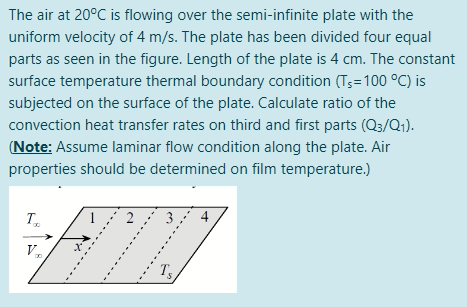The air at 20°C is flowing over the semi-infinite plate with the uniform velocity of 4 m/s. The plate has been divided four equal parts as seen in the figure. Length of the plate is 4 cm. The constant surface temperature thermal boundary condition (T3=100 °C) is subjected on the surface of the plate. Calculate ratio of the convection heat transfer rates on third and first parts (Q3/Q1). (Note: Assume laminar flow condition along the plate. Air properties should be determined on film temperature.) T. 2 V,
The air at 20°C is flowing over the semi-infinite plate with the uniform velocity of 4 m/s. The plate has been divided four equal parts as seen in the figure. Length of the plate is 4 cm. The constant surface temperature thermal boundary condition (T3=100 °C) is subjected on the surface of the plate. Calculate ratio of the convection heat transfer rates on third and first parts (Q3/Q1). (Note: Assume laminar flow condition along the plate. Air properties should be determined on film temperature.) T. 2 V,
Principles of Heat Transfer (Activate Learning with these NEW titles from Engineering!)
8th Edition
ISBN:9781305387102
Author:Kreith, Frank; Manglik, Raj M.
Publisher:Kreith, Frank; Manglik, Raj M.
Chapter5: Analysis Of Convection Heat Transfer
Section: Chapter Questions
Problem 5.25P
Related questions
Question
I need it urgently thank you

Transcribed Image Text:The air at 20°C is flowing over the semi-infinite plate with the
uniform velocity of 4 m/s. The plate has been divided four equal
parts as seen in the figure. Length of the plate is 4 cm. The constant
surface temperature thermal boundary condition (Ts=100 °C) is
subjected on the surface of the plate. Calculate ratio of the
convection heat transfer rates on third and first parts (Q3/Q;).
(Note: Assume laminar flow condition along the plate. Air
properties should be determined on film temperature.)
T.
1
4
V.
Ts
Expert Solution
This question has been solved!
Explore an expertly crafted, step-by-step solution for a thorough understanding of key concepts.
Step by step
Solved in 2 steps

Knowledge Booster
Learn more about
Need a deep-dive on the concept behind this application? Look no further. Learn more about this topic, mechanical-engineering and related others by exploring similar questions and additional content below.Recommended textbooks for you

Principles of Heat Transfer (Activate Learning wi…
Mechanical Engineering
ISBN:
9781305387102
Author:
Kreith, Frank; Manglik, Raj M.
Publisher:
Cengage Learning

Principles of Heat Transfer (Activate Learning wi…
Mechanical Engineering
ISBN:
9781305387102
Author:
Kreith, Frank; Manglik, Raj M.
Publisher:
Cengage Learning